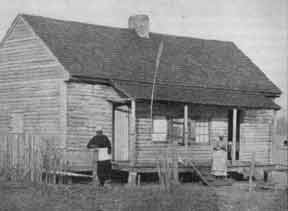Family Life
|
 Migrant Family Traveling to Chicago Migrant Family Traveling to Chicago
|
|
The African American family provided the core unit of the Great Migration. It was these families that came
to the North to seek out a better life. The strong ties of the African American family facilitated migration, enabling
one or two members to travel north before sending for the remainder of the families.
Typically, Delta sharecropper worker as a family in the land, with
each member assigned to a specific task that contributed to the greater
whole. Families tended to be large because of the endless jobs and chores
which needed to be completed each day. Blondine Heron
is a perfect example of being part of the large families that lived in the
south;she was one of fourteen children. The more children, the more hands
to work the soil. Each new born child, however, also meant another mouth
to feed. |
| The family provided almost all the social life for the children in the Delta. The vast plantations of the
Delta made it so that neighbors were few and far between. In the fields of the sharecropper and in the home, children
formed relationships with their many brothers and sisters. The lack of schooling in the rural Delta reinforced
the closeness of the Delta families. The school year only lasted four months during planting or harvesting season.
Children interacted with other children outside of their families for only four months out of the year.These were
some of the contributing factors to the strength of the Delta families, but another reason for close families to
be unified was the hatred whites in the Delta felt for African Americans. Episodes such as the Emmett Till case
demonstrated to the southern families how important it was |
|
 Sharecropper's House in Mississippi Sharecropper's House in Mississippi
|
for families to remain a tight and unified group. Racism, segregation and oppression led many African American
families to the North during World War I and World War II. It was the tight bonds of southern African American
families that made the migration successful.
|
 Migrant Family
Migrant Family
|
|
To join the Great Migration was a bold and daring step. People often traveled with family or traveled to
join family already in the North. Once in the North, African Americans secured jobs and then sent for the rest
of their families. The migration of a family could take years, but the wait was worth it because the South offered
no possible advancement for the African American family.
In the North the families changed. People who traveled north rarely did so in families, but rather as individuals
or as portions of the family. Once in the North these members of the family lived together in apartment buildings
and saved |
money to send for the rest of their family. The change in the living
space of the changed the structure of the family.
One of the larger, more noticeable changes of the African American was the size of the family. The number
of children born in the North was significantly less in part because of the difference of space the African American
families had. Rather then having access to sprawling land, they found themselves confined to small apartments on
the south and west side of Chicago.
People were able to broaden their horizons and experienced new things, such as nine months of school
and a variety of jobs social clubs, and churches. Men and women to met many more people in the Northern cities
in a variety of places. The family did indeed change but did not disintergrate.
Though there was not the blatant racism in the north as there was in the south, migrants often faced
discrimination. The family unit provided support as the migrants adjusted to their new environment. The northern
family members told the new migrants how things worked and the rules of the North. Almost all migrants stayed with
family members when they initially arrived in city of Chicago. The family is a safe unit of support for people
in times of adversity. The life that African Americans had to endure in the south made it necessary for families
to remain a close group and this close group lead to success of the Great Migration.

 Migrant Family Traveling to Chicago
Migrant Family Traveling to Chicago
 Sharecropper's House in Mississippi
Sharecropper's House in Mississippi
 Migrant Family
Migrant Family
